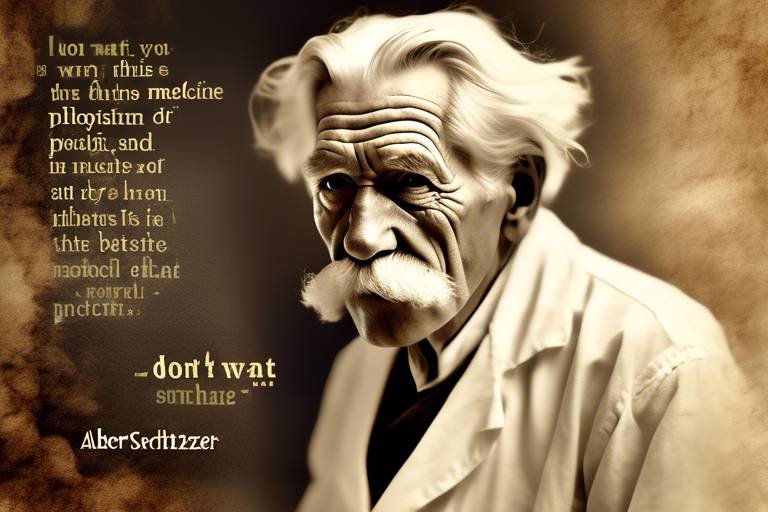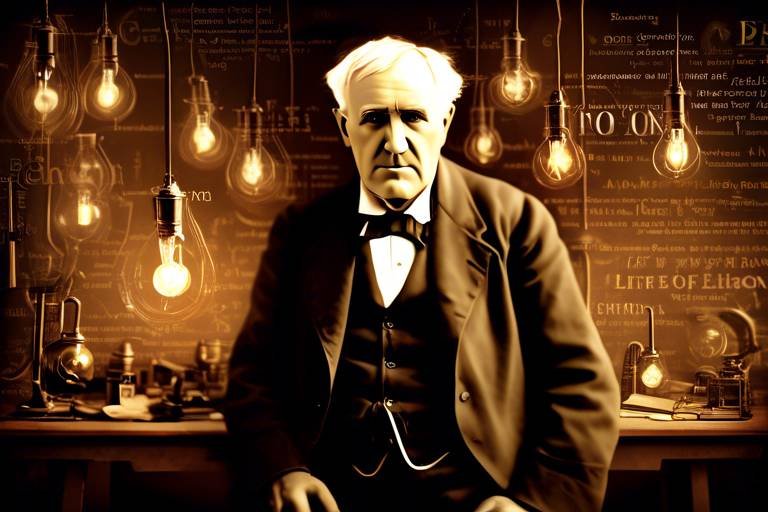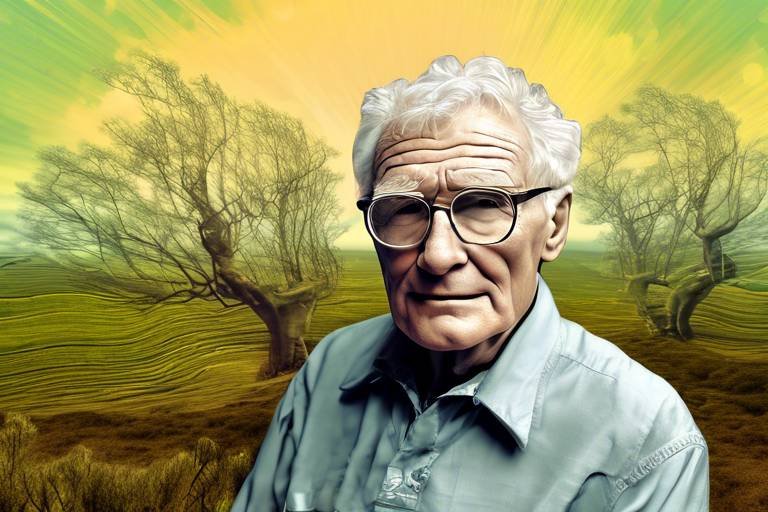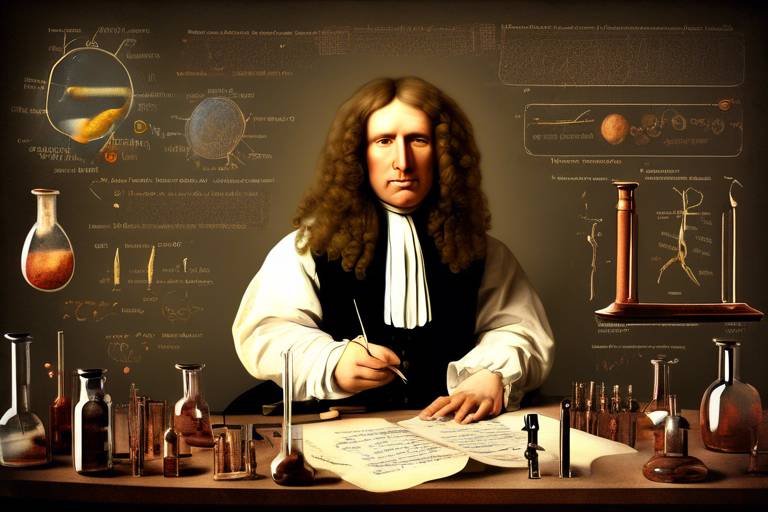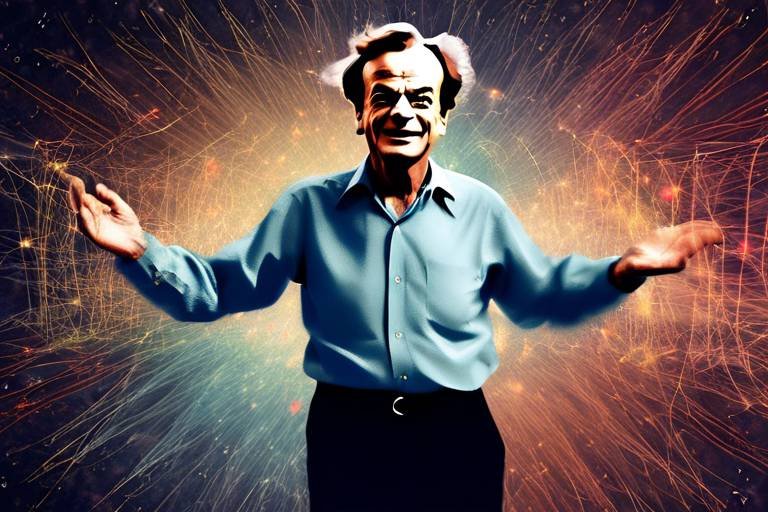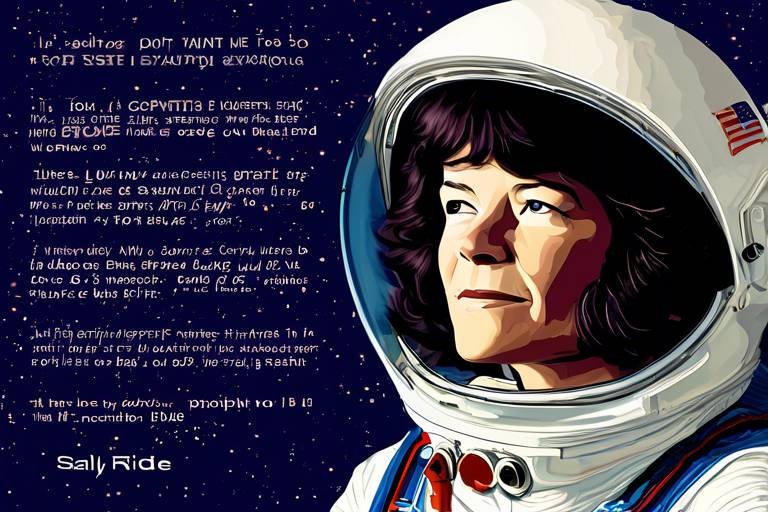The Discoveries of Richard Feynman in Quantum Electrodynamics
Richard Feynman, a name synonymous with brilliance and creativity, made groundbreaking contributions to the field of quantum electrodynamics (QED), a branch of theoretical physics that studies how light and matter interact. His work not only revolutionized our understanding of these interactions but also provided a new lens through which we can view the fundamental workings of the universe. Imagine standing at the edge of a vast ocean of knowledge, and Feynman is the lighthouse guiding you through the turbulent waters of quantum theory. His insights and innovations have left an indelible mark on modern physics, inspiring countless scientists and enthusiasts alike.
Feynman's journey into the depths of QED began in the mid-20th century, a time when the scientific community was grappling with the complexities of electromagnetic interactions. His unique approach to problem-solving, characterized by a combination of intuition and rigorous mathematical formulation, allowed him to develop concepts that were not only groundbreaking but also accessible. For instance, Feynman's introduction of Feynman diagrams transformed the way physicists visualize particle interactions. These diagrams serve as a bridge between abstract mathematics and physical reality, offering a clear and intuitive way to understand complex processes that occur at the quantum level.
One of the most fascinating aspects of Feynman's work is his treatment of virtual particles. These ephemeral entities, which pop in and out of existence, play a crucial role in the interactions depicted in Feynman diagrams. They may seem elusive, but they adhere to the strict laws of energy conservation, challenging our classical notions of what particles are. To think of virtual particles is to think of ghosts in a way—present but never fully tangible, yet their effects are undeniably real. This concept has profound implications, not just for theoretical physics but also for practical applications in fields such as quantum computing and particle physics.
Feynman's path integral formulation further revolutionized the landscape of quantum mechanics. By emphasizing the idea that a particle can take an infinite number of paths, he opened the door to a new way of thinking about quantum behavior. This perspective allows physicists to calculate probabilities of different outcomes in a more holistic manner, considering all possible histories of a particle rather than just a single trajectory. It's akin to watching a movie with multiple endings, where each possible path contributes to the final outcome. This innovative thinking has paved the way for numerous advancements in theoretical predictions and calculations, solidifying Feynman's status as a pioneer in the field.
Today, the impacts of Feynman's discoveries in QED resonate throughout modern physics. His contributions have shaped research in particle physics, cosmology, and beyond, inspiring new generations of physicists to explore the quantum realm. The legacy of Richard Feynman is not merely confined to his scientific achievements; it extends into the realm of education and popular science. His unique ability to communicate complex ideas with clarity and enthusiasm has made him an enduring figure, encouraging curiosity and wonder in the minds of many.
As we continue to delve deeper into the mysteries of quantum electrodynamics, it's essential to recognize that the field remains vibrant and dynamic. Ongoing research builds upon Feynman's foundational work, revealing new discoveries that expand our understanding of the universe at its most fundamental level. The journey through the quantum world is far from over, and Feynman's spirit of inquiry and exploration continues to inspire scientists as they navigate the complexities of reality.
- What is Quantum Electrodynamics (QED)? - QED is a quantum field theory that describes how light and matter interact, focusing on the electromagnetic force.
- Who was Richard Feynman? - Richard Feynman was an American theoretical physicist known for his work in quantum mechanics, quantum electrodynamics, and for popularizing science.
- What are Feynman diagrams? - Feynman diagrams are graphical representations of particle interactions used to simplify complex calculations in quantum physics.
- What are virtual particles? - Virtual particles are temporary particles that exist in quantum field theory and are used to explain interactions between particles.
- How did Feynman's work influence modern physics? - Feynman's contributions have shaped contemporary research in various fields, including particle physics and cosmology, inspiring ongoing exploration in quantum mechanics.

The Birth of Quantum Electrodynamics
Quantum electrodynamics (QED) is a fascinating field that emerged in the mid-20th century, fundamentally reshaping our comprehension of how light and matter interact. Imagine a world where particles dance in a cosmic ballet, where photons and electrons engage in a constant exchange of energy and momentum. This was the reality that physicists like Richard Feynman began to uncover, paving the way for a new understanding of electromagnetic interactions. The birth of QED marked a significant milestone in physics, as it combined the principles of quantum mechanics with the classical theories of electromagnetism, creating a robust framework that could explain phenomena previously deemed mysterious.
Feynman's contributions to QED were not just theoretical; they were revolutionary. He, along with other prominent physicists, such as Julian Schwinger and Sin-Itiro Tomonaga, laid down the mathematical foundations that would allow scientists to predict the behavior of particles with astonishing accuracy. Their work was a collaborative effort that bridged gaps in existing theories, leading to the formulation of a comprehensive model that describes how light interacts with charged particles. This synergy of ideas was akin to a symphony, where each physicist played a crucial role in creating a harmonious understanding of the quantum world.
To truly appreciate the significance of QED's birth, we must recognize the context in which it developed. The early 20th century was a time of great upheaval in the scientific community. Classical physics, which had served as the bedrock of understanding for centuries, was beginning to show its limitations. The advent of quantum mechanics introduced concepts that challenged traditional views, leading to a revolution in how we perceive the universe. In this tumultuous landscape, QED emerged as a beacon of clarity, offering insights that bridged the gap between the microcosm of particles and the macrocosm of electromagnetic waves.
One of the key aspects that set QED apart from its predecessors was its ability to incorporate the idea of **quantum fluctuations**. This concept suggests that particles are not static entities; instead, they are in a constant state of flux, popping in and out of existence. This revelation was groundbreaking and opened the door to understanding complex interactions that occur at the subatomic level. Feynman's innovative thinking allowed him to visualize these interactions in a way that was both intuitive and mathematically rigorous, leading to the development of the now-famous Feynman diagrams.
In summary, the birth of quantum electrodynamics was not merely a scientific milestone; it was a paradigm shift that changed the way we understand the universe. Feynman and his contemporaries did not just build upon existing theories; they redefined the very fabric of physics. Their work continues to inspire new generations of physicists, as we delve deeper into the mysteries of the quantum realm, forever grateful for the groundwork laid by these pioneers.

Feynman Diagrams Explained
When we talk about Feynman diagrams, we're diving into a visual language that Richard Feynman crafted to simplify the complicated world of particle interactions. Imagine trying to explain a complex dance between particles; without a visual aid, it can become a chaotic mess of equations and theories. Feynman had the genius to create these diagrams, which act like a map, guiding us through the intricate steps of quantum interactions.
At their core, Feynman diagrams are a way to represent the interactions between particles like electrons and photons. Each element of the diagram corresponds to a specific aspect of these interactions. For instance, straight lines typically represent particles traveling through space, while wavy lines symbolize force-carrying particles, such as photons. This visual representation allows physicists to grasp the underlying processes of quantum electrodynamics (QED) without getting lost in a sea of mathematical symbols.
To break it down further, let’s consider the basic components of a Feynman diagram:
- Vertices: Points where lines meet, indicating interactions between particles.
- External Lines: Represent incoming and outgoing particles, showing what enters and exits the interaction.
- Internal Lines: Indicate virtual particles that exist temporarily during the interaction.
What’s remarkable about these diagrams is their ability to simplify complex calculations. Instead of laboriously working through equations, physicists can use these diagrams to visualize interactions and apply rules that translate the diagrams back into mathematical expressions. This process is not only more intuitive but also allows for quicker calculations, making it an invaluable tool in theoretical physics.
For example, in a typical interaction involving an electron and a photon, the Feynman diagram would illustrate how the electron emits or absorbs the photon, showcasing the interaction's dynamics. This visual representation can be a game-changer when tackling challenging problems in particle physics, as it reduces the cognitive load on scientists trying to conceptualize the interactions occurring at the quantum level.
Moreover, Feynman diagrams have become a universal language among physicists. They transcend linguistic barriers and allow scientists from different backgrounds to communicate complex ideas effectively. Whether you are in a lab in California or a conference in Tokyo, a Feynman diagram can convey intricate concepts with clarity and precision.
In essence, Feynman diagrams are not just tools for calculation; they are a bridge between the complex world of quantum mechanics and our understanding of the universe. They encapsulate the beauty of particle interactions in a way that is both accessible and profound, making them a cornerstone of modern theoretical physics.
Q1: What is the main purpose of Feynman diagrams?
A1: Feynman diagrams serve as a visual representation of particle interactions, simplifying complex calculations and helping physicists understand quantum electrodynamics.
Q2: How do Feynman diagrams represent virtual particles?
A2: In Feynman diagrams, virtual particles are depicted as internal lines connecting vertices, representing transient states during particle interactions.
Q3: Can Feynman diagrams be used in other areas of physics?
A3: Yes, while they are primarily associated with quantum electrodynamics, Feynman diagrams can also be applied in other fields, such as quantum chromodynamics and statistical mechanics.

The Role of Virtual Particles
The concept of virtual particles is one of the most fascinating and somewhat perplexing aspects of quantum electrodynamics (QED). These particles, unlike their more tangible counterparts, do not exist in the same way that we perceive particles in our everyday lives. Instead, they are transient entities that emerge during particle interactions. Imagine a bustling city where people come and go, creating a vibrant atmosphere. In the quantum realm, virtual particles are akin to those fleeting visitors, appearing momentarily before disappearing again. They are not directly observable, yet their influence is profoundly felt in the interactions of particles.
To understand the role of virtual particles, it's crucial to recognize that they represent intermediate states in the interactions between real particles. For instance, when an electron and a positron collide, they can exchange virtual photons—these are the carriers of electromagnetic force. This exchange is not a straightforward process; rather, it's a complex dance of probabilities. Virtual particles allow physicists to calculate the likelihood of various outcomes in particle interactions, making them an essential tool in the theoretical framework of QED.
One of the most intriguing features of virtual particles is their relationship with energy conservation. Although they may seem ephemeral, virtual particles still adhere to the fundamental laws of physics. They can momentarily "borrow" energy, as long as they return it within a time frame dictated by the uncertainty principle. This concept challenges classical physics, where particles are expected to have well-defined properties at all times. Instead, the behavior of virtual particles illustrates the strange and counterintuitive nature of quantum mechanics.
Furthermore, virtual particles are not just an abstract concept; they have real-world implications. For instance, they play a vital role in phenomena such as the Casimir effect, where the vacuum fluctuations of virtual particles create a measurable force between two closely spaced plates. This effect is a testament to the reality of virtual particles and their impact on our understanding of the universe. Additionally, in the realm of quantum computing, the principles of virtual particles are being harnessed to develop new technologies that could revolutionize how we process information.
In summary, virtual particles are a cornerstone of quantum electrodynamics, serving as the invisible threads that connect different aspects of particle interactions. They challenge our classical intuitions and open up new avenues for exploration in both theoretical and experimental physics. As we delve deeper into the quantum world, understanding the role of these elusive entities will undoubtedly enhance our grasp of the fundamental workings of the universe.
- What are virtual particles? Virtual particles are transient entities that appear during particle interactions, representing intermediate states that help explain electromagnetic forces.
- How do virtual particles adhere to energy conservation? Virtual particles can temporarily "borrow" energy, provided they return it within a time frame determined by the uncertainty principle.
- What is the Casimir effect? The Casimir effect is a physical force arising from the vacuum fluctuations of virtual particles, observable between closely spaced plates.
- Why are virtual particles important in quantum computing? Virtual particles contribute to the principles of quantum mechanics that underpin the development of quantum computing technologies.

Virtual Particles and Energy Conservation
When we delve into the world of quantum mechanics, one of the most fascinating concepts that emerge is that of virtual particles. These elusive entities are not your typical particles; they exist only for a fleeting moment, popping in and out of existence in a manner that can seem almost magical. But what does this mean for energy conservation? At first glance, it might appear that these transient particles could violate the sacred laws of physics, particularly the principle of energy conservation. However, the reality is far more intriguing.
Virtual particles are integral to the interactions described in Feynman diagrams. They act as mediators for forces, like photons in electromagnetic interactions. During these interactions, virtual particles can momentarily "borrow" energy, allowing them to exist briefly before annihilating themselves. This phenomenon is a direct consequence of the Heisenberg Uncertainty Principle, which states that the more precisely the position of a particle is known, the less precisely its momentum can be known, and vice versa. This uncertainty allows for the temporary violation of energy conservation, but only for a very short time frame, adhering to the relationship ΔEΔt ≥ ħ/2.
To illustrate this point, consider the analogy of a child borrowing a toy. If the child borrows the toy for a short time and returns it quickly, there is no real loss to the owner. Similarly, virtual particles "borrow" energy from the vacuum of space, but they must return it almost instantly, ensuring that the overall energy balance remains intact. This concept challenges our classical intuitions about particles and energy, revealing a more complex and nuanced picture of the quantum world.
Furthermore, the implications of virtual particles extend beyond theoretical discussions. They play a significant role in various physical phenomena, including Hawking radiation and the Casimir effect, demonstrating their tangible effects on our universe. In the case of Hawking radiation, virtual particles near the event horizon of a black hole can manifest as real particles, leading to the gradual evaporation of the black hole over time. This fascinating interplay between virtual and real particles showcases the intricate dance of energy conservation at the quantum level.
In summary, while virtual particles may seem to flirt with the idea of energy conservation, they actually operate within its framework. Their ephemeral nature and the rules governing their existence ensure that energy remains conserved in the grand scheme of the universe. As we continue to explore the depths of quantum electrodynamics, understanding virtual particles will be key to unlocking even more secrets of the cosmos.

Applications of Virtual Particles
Virtual particles, though fleeting and elusive, have profound implications that extend far beyond the realm of theoretical physics. These ephemeral entities are not just abstract concepts; they play a crucial role in various cutting-edge technologies and scientific advancements. For instance, in the field of quantum computing, virtual particles contribute to the understanding of quantum states and entanglement, which are foundational for developing quantum algorithms. Imagine virtual particles as the invisible threads weaving together the fabric of quantum information, enabling computers to process data in ways classical computers can only dream of.
Moreover, virtual particles are instrumental in the phenomenon known as Casimir effect, where two uncharged plates placed in a vacuum experience an attractive force due to the fluctuations of virtual particles in the vacuum. This effect has practical applications in nanotechnology, where it can influence the behavior of small-scale devices. As researchers delve deeper into the implications of virtual particles, they find that these interactions can lead to innovations in materials science, particularly in the design of new materials with tailored properties.
Additionally, virtual particles are at the heart of our understanding of particle physics. They facilitate interactions between fundamental particles, acting as mediators in processes such as electron-positron annihilation or the scattering of photons. This understanding is crucial for experiments conducted at particle accelerators, such as the Large Hadron Collider (LHC), where scientists probe the fundamental forces of nature. By studying these interactions, physicists can uncover new particles and forces, pushing the boundaries of our understanding of the universe.
In summary, the applications of virtual particles are vast and varied. They not only enhance our theoretical understanding but also pave the way for practical advancements in technology and materials science. As we continue to explore the quantum realm, the significance of these elusive entities will only grow, revealing new insights and applications that could revolutionize our world.
- What are virtual particles?
Virtual particles are temporary fluctuations that occur in quantum fields, representing transient states during particle interactions. They are not directly observable but have measurable effects on physical phenomena.
- How do virtual particles relate to quantum mechanics?
Virtual particles are integral to quantum mechanics, helping to explain interactions between particles and the forces that govern them. They illustrate the non-intuitive nature of quantum systems.
- Can virtual particles be detected?
While virtual particles themselves cannot be detected directly, their effects can be observed through phenomena like the Casimir effect and in particle collision experiments.
- What is the significance of virtual particles in quantum computing?
In quantum computing, virtual particles help in understanding quantum states and entanglement, which are essential for developing efficient quantum algorithms and technologies.

Feynman's Path Integral Formulation
Richard Feynman's Path Integral Formulation of quantum mechanics is nothing short of revolutionary, reshaping how we understand the behavior of particles at a quantum level. Instead of adhering to the traditional framework of quantum mechanics, which often feels rigid and confining, Feynman introduced a more fluid and dynamic perspective. Imagine a bustling city where every possible route a person could take to reach their destination is considered, rather than just the most direct one. This is essentially what Feynman did for quantum particles—he proposed that instead of following a single path, particles explore all possible paths simultaneously.
At the heart of this formulation lies the concept of "summing over histories." Feynman suggested that to determine the probability of a particle's behavior, we should consider every conceivable path it could take between two points. Each path contributes to the overall probability amplitude, and the final result is obtained by adding these contributions together. This approach not only simplifies calculations but also provides deeper insights into the nature of quantum mechanics.
To illustrate this, consider the following table that summarizes the key elements of the Path Integral Formulation:
| Element | Description |
|---|---|
| Paths | All possible trajectories a particle can take. |
| Probability Amplitude | Complex number representing the likelihood of a particle's path. |
| Sum Over Histories | Adding contributions from all paths to find the total probability. |
| Interference | Paths can interfere with one another, affecting the final outcome. |
This method not only provides a powerful tool for calculations but also opens up new avenues for understanding quantum phenomena. For instance, it helps explain the concept of quantum superposition, where particles can exist in multiple states at once. Just like a musician can play multiple notes simultaneously, particles can 'choose' from a multitude of paths, and their final state is a beautiful symphony of all those possibilities.
Moreover, Feynman's formulation has profound implications for fields like quantum field theory and string theory. By embracing the idea that particles are not confined to a single trajectory, researchers can explore complex interactions in a more holistic manner. It’s like viewing a vast landscape from a helicopter instead of being stuck at ground level; you gain a broader understanding of the topography and how various elements interact with one another.
As we delve deeper into the quantum realm, Feynman's Path Integral Formulation continues to inspire physicists to question traditional paradigms and explore new theoretical frontiers. It invites us to embrace the uncertainty and complexity of the universe, reminding us that sometimes the journey is just as important as the destination.

Impacts on Modern Physics
Richard Feynman's contributions to quantum electrodynamics (QED) have had profound and far-reaching impacts on modern physics. His innovative ideas not only reshaped our understanding of electromagnetic interactions but also paved the way for new research avenues that continue to evolve today. One of the most significant impacts of Feynman's work is the establishment of a robust framework for understanding particle physics, which has become foundational in the study of the universe at its most fundamental level.
Feynman's unique approach to theoretical physics, particularly through his introduction of Feynman diagrams, has transformed how physicists visualize and calculate particle interactions. These diagrams serve as a bridge between abstract mathematical concepts and tangible physical phenomena, making complex calculations more accessible. As a result, they have become essential tools in various fields, including high-energy physics, condensed matter physics, and even quantum computing.
Moreover, Feynman's path integral formulation revolutionized quantum mechanics by proposing that particles do not follow a single path but rather take every possible route. This perspective has led to significant advancements in the understanding of quantum fields and has influenced the development of modern theories, such as string theory and quantum gravity. The implications of this approach are vast, offering insights into phenomena that were previously deemed too complex to analyze.
Feynman's work has also inspired a new generation of physicists to explore the quantum realm. His ability to communicate complex ideas in an engaging and relatable manner has made him a beloved figure in both scientific and educational communities. The legacy of his teaching style continues to impact how physics is taught, encouraging a more intuitive and conceptual approach to learning that resonates with students around the world.
In addition to theoretical advancements, Feynman's contributions have practical implications that extend into various technologies. For instance, the principles of QED are crucial in the development of technologies such as lasers, semiconductors, and even medical imaging techniques like PET scans. These applications not only demonstrate the relevance of QED in everyday life but also highlight how theoretical physics can lead to groundbreaking technological innovations.
| Impact Area | Description |
|---|---|
| Particle Physics | Foundation for understanding particle interactions and the Standard Model. |
| Quantum Computing | Influence on algorithms and technologies leveraging quantum mechanics. |
| Medical Imaging | Applications of QED principles in technologies like PET scans. |
| Education | Legacy of teaching methods that simplify complex concepts for students. |
Feynman's legacy in modern physics is not just about the discoveries he made but also about the way he approached science. His insistence on questioning established norms and encouraging curiosity has left an indelible mark on the scientific community. As researchers continue to build on his work, the field of quantum electrodynamics remains a vibrant area of study, with new discoveries and insights emerging regularly. This ongoing research not only honors Feynman's contributions but also fuels the quest to understand the universe at a deeper level.
- What is Quantum Electrodynamics (QED)?
QED is the quantum field theory that describes how light and matter interact, focusing on the electromagnetic force. - How did Feynman contribute to QED?
Feynman introduced innovative visual tools like Feynman diagrams and the path integral formulation, which simplified complex calculations in particle physics. - Why are Feynman diagrams important?
They provide a clear and intuitive way to visualize and calculate particle interactions, making them essential in theoretical physics. - What are virtual particles?
Virtual particles are transient states that appear in particle interactions, playing a crucial role in the calculations of QED. - How has Feynman's work influenced modern technology?
His contributions to QED have led to advancements in technologies like lasers, semiconductors, and medical imaging techniques.

Legacy of Richard Feynman
Richard Feynman's legacy is a tapestry woven with threads of scientific brilliance, creativity, and an insatiable curiosity about the universe. His contributions to quantum electrodynamics (QED) not only transformed the field of physics but also reshaped how we perceive the fundamental interactions of nature. Feynman was not just a physicist; he was a master at communicating complex ideas in a way that made them accessible to everyone. His unique teaching style, characterized by enthusiasm and clarity, inspired countless students and professionals alike.
One of the most enduring aspects of Feynman's legacy is his ability to simplify the complex. Through his famous Feynman Diagrams, he provided a visual language that allowed physicists to represent particle interactions in a clear and intuitive manner. These diagrams have become essential tools in theoretical physics, enabling researchers to visualize and calculate interactions that would otherwise be incomprehensible. They serve as a testament to Feynman's belief that physics should not just be about equations and abstract concepts, but about understanding the fundamental processes that govern our universe.
Beyond his scientific achievements, Feynman was a vibrant personality who embraced life with a sense of wonder and humor. He was known for his love of teaching, often saying, "If you can’t explain it to a six-year-old, you don’t understand it yourself." This philosophy guided his approach to education and outreach, making him a beloved figure in popular science. His books, such as "Surely You're Joking, Mr. Feynman!" and "The Feynman Lectures on Physics", continue to captivate readers, blending personal anecdotes with profound scientific insights.
Feynman’s influence extends into various fields beyond physics. His work has inspired advancements in quantum computing, where the principles of QED are foundational. Moreover, his approach to problem-solving, characterized by creativity and unconventional thinking, has encouraged scientists and engineers to explore new avenues in research and technology. Feynman once said, "The first principle is that you must not fool yourself—and you are the easiest person to fool." This mindset encourages critical thinking and skepticism, essential qualities in scientific inquiry.
In summary, Richard Feynman's legacy is not merely confined to his scientific discoveries but is also reflected in his approach to life, education, and communication. He has left an indelible mark on the world of physics and beyond, inspiring future generations to pursue knowledge with passion and integrity. As we continue to explore the mysteries of the universe, Feynman's spirit lives on in the hearts and minds of those who dare to question, discover, and understand.
- What is quantum electrodynamics?
Quantum electrodynamics is the relativistic quantum field theory of electrodynamics, describing how light and matter interact. - What are Feynman Diagrams?
Feynman Diagrams are pictorial representations of the mathematical expressions governing the behavior of subatomic particles, simplifying complex interactions. - Why are virtual particles important?
Virtual particles are crucial in understanding particle interactions as they represent transient states that contribute to the forces between particles. - How did Feynman influence modern physics?
Feynman's innovative ideas and methods have shaped research in various fields, including particle physics and quantum computing, continuing to inspire scientists today.

Continued Research in QED
Quantum electrodynamics (QED) is a field that is far from stagnant; in fact, it is a vibrant and dynamic area of research that continues to captivate physicists around the globe. The foundational work laid down by Richard Feynman has opened numerous pathways for exploration, leading to a multitude of new discoveries and innovations. As researchers delve deeper into the quantum realm, they are not only revisiting Feynman's original ideas but also pushing the boundaries of what we know about light and matter interactions.
One of the most exciting aspects of ongoing QED research is its intersection with other fields of physics. For instance, advancements in quantum computing are heavily influenced by principles derived from QED. Scientists are investigating how quantum bits (qubits) can be manipulated at the quantum level, often employing Feynman’s insights as a foundation. This interplay between QED and quantum computing is paving the way for technologies that could revolutionize everything from cryptography to complex problem-solving.
Moreover, the phenomenon of quantum entanglement, which has become a hot topic in modern physics, is also deeply rooted in the principles of QED. Researchers are exploring how entangled particles can communicate instantaneously over vast distances, a concept that seems to defy classical physics. This has significant implications for our understanding of the universe and could lead to breakthroughs in communication technologies.
In addition to theoretical advancements, experimental physics is witnessing a renaissance thanks to QED. Innovative experiments are being designed to test the limits of quantum theories and to observe phenomena that were previously thought to be purely theoretical. For example, experiments at particle accelerators are probing the interactions between particles with unprecedented precision, allowing scientists to validate or challenge existing theories.
To give you a clearer picture of the current landscape in QED research, here’s a brief overview of some key areas of focus:
| Research Area | Description |
|---|---|
| Quantum Computing | Investigating the application of QED principles in developing qubits and quantum algorithms. |
| Quantum Entanglement | Exploring the implications of entangled states and their potential for instant communication. |
| Particle Physics Experiments | Conducting high-energy experiments to observe particle interactions and validate QED predictions. |
| Quantum Field Theory | Refining mathematical frameworks that extend QED to incorporate other fundamental forces. |
As we look to the future, the question remains: where will the next breakthroughs in QED come from? Researchers are optimistic that by continuing to build on Feynman's legacy, they will unlock new understandings of the universe that could change our very perception of reality. The journey through the quantum world is just beginning, and with each discovery, we are reminded of the profound mysteries that still lie ahead.
- What is Quantum Electrodynamics (QED)?
QED is the quantum field theory that describes how light and matter interact, forming the basis for much of modern physics. - How did Richard Feynman contribute to QED?
Feynman introduced innovative concepts such as Feynman diagrams and the path integral formulation, which simplified complex calculations in quantum mechanics. - Why are virtual particles important in QED?
Virtual particles are integral to understanding particle interactions and play a crucial role in the calculations performed in QED. - What are some current research areas in QED?
Research areas include quantum computing, quantum entanglement, and experimental particle physics, all of which continue to evolve and expand our understanding of the quantum world.
Frequently Asked Questions
- What is Quantum Electrodynamics (QED)?
Quantum Electrodynamics, or QED, is a fundamental theory in physics that describes how light and matter interact. It's like the bridge connecting the electromagnetic force with quantum mechanics, allowing us to understand the behavior of photons and charged particles at a microscopic level.
- How did Richard Feynman contribute to QED?
Richard Feynman made groundbreaking contributions to QED by developing a new way to visualize particle interactions through Feynman diagrams. These diagrams simplify complex calculations and have become essential tools for physicists, making it easier to understand and predict particle behavior.
- What are Feynman diagrams?
Feynman diagrams are pictorial representations of particle interactions. Imagine them as a map of a journey taken by particles, showing how they collide, scatter, or transform. They provide an intuitive way to visualize and calculate the probabilities of various quantum events.
- What are virtual particles?
Virtual particles are temporary fluctuations that occur during particle interactions. Think of them as fleeting guests at a party, popping in and out of existence. They play a crucial role in Feynman diagrams, helping to explain the forces between particles even though they can't be directly observed.
- How do virtual particles relate to energy conservation?
Even though virtual particles are short-lived, they still obey the laws of energy conservation. This might seem counterintuitive, but it highlights the unique and often surprising behavior of quantum systems, challenging our classical understanding of particles and energy.
- What is Feynman's path integral formulation?
Feynman's path integral formulation is a revolutionary approach to quantum mechanics that suggests a particle takes all possible paths to reach its destination. This perspective allows physicists to calculate probabilities in a more holistic way, considering every conceivable route a particle might take.
- What impact did Feynman's work have on modern physics?
Feynman's contributions to QED have profoundly influenced contemporary physics, shaping research in areas like particle physics and cosmology. His innovative ideas continue to inspire new generations of physicists as they explore the complexities of the quantum realm.
- Why is Richard Feynman's legacy important?
Feynman's legacy is significant not only for his scientific discoveries but also for his unique approach to teaching complex concepts. He made science accessible and engaging, inspiring countless individuals to delve into the wonders of physics and the universe.
- Is research in QED still ongoing?
Absolutely! The field of quantum electrodynamics is vibrant and continuously evolving. Researchers are building upon Feynman's foundational work, leading to new discoveries that expand our understanding of the universe at its most fundamental level.



